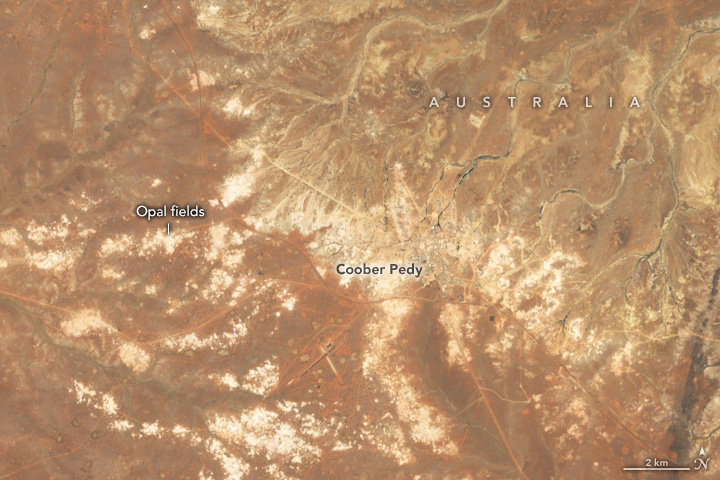
Keeping it Cool in the Outback
Downloads
- cooberpedy_oli_2023310_lrg.jpg (1143x762, JPEG)
Metadata
- Sensor(s):
- Landsat 8 - OLI
- Data Date: November 6, 2023
- Visualization Date: November 17, 2023
The heat in the South Australian outback town of Coober Pedy gets extreme. The hottest summer temperatures in this treeless, rocky desert reportedly reach 52 degrees Celsius (126 degrees Fahrenheit). Despite this, many of the town’s approximately 2,000 residents have found it’s possible, if not comfortable, to exist in the harsh environment: About half of them live underground.
The discovery of opal in the area led to the establishment of the town and ultimately to its unconventional style of architecture. Located about 850 kilometers (530 miles) north-northwest of Adelaide, the opal fields were given the name Coober Pedy, an aboriginal term meaning “white man in a hole,” in 1920. The town’s growth started to take off in the late 1960s, driven by an increased demand for opal, a supply of workers seeking fortune, and improvements in mining tools.
The OLI (Operational Land Imager) on Landsat 8 acquired this image of Coober Pedy on November 6, 2023. Outlines of human settlements and remnants of mining activities stand out against the parched red surroundings. The geologic setting provided favorable conditions for the colorful gemstone to form. Opal is chemically similar to quartz but lacks its highly ordered crystalline structure. It formed in abundance around Coober Pedy millions of years ago when dissolved silica precipitated out of groundwater and filled in cracks in the sandstone.
Hidden from satellite view is a network of subterranean spaces dug out of the soft, porous bedrock. Underground living enables effective low-energy, low-tech climate control through passive cooling. In these homes, hotels, and restaurants, the temperature remains an almost constant 23°C (73°F). Ventilation shafts run up to the surface to ensure the supply of oxygen and to release moisture. The arid climate of the outback also helps keep rooms from becoming damp and musty. Plus, occupants can custom-carve spaces to their liking.
While opal mining has tailed off in recent years, the town attracts tourists who want to experience the novelty of underground living. Visitors can also tour old opal mines or venture to the surface to play 18 holes of golf on a grassless course. To the north of this scene, the Kanku-Breakaways Conservation Park is known for its colorful hills, flat-topped mesas, and stony desert landscapes known as “gibber plains” or “moon plains.”
A grid of mostly renewable energy now supplies the town’s power needs, augmenting the older sustainable technology of passive cooling. An energy project completed in 2017 integrated solar, wind, and battery storage technologies with an existing diesel generator. On several occasions, the grid has operated on 100 percent renewable power for over 90 hours at a time.
References
- BBC (2023, August 3) The Australian town where people live underground. Accessed November 17, 2023.
- Coober Pedy Historical Society Timeline. Accessed November 17, 2023.
- District Council of Coober Pedy Explore Coober Pedy. Accessed November 17, 2023.
- National Parks and Wildlife Service Kanku-Breakaways Conservation Park. Accessed November 17, 2023.
- South Australia Department for Energy and Mining Opal. Accessed November 17, 2023.
NASA Earth Observatory image by Wanmei Liang, using Landsat data from the U.S. Geological Survey. Story by Lindsey Doermann.
This image record originally appeared on the Earth Observatory. Click here to view the full, original record.